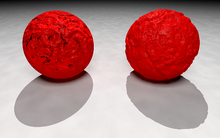File:Bump map vs isosurface2.png

Original file (1,680 × 1,050 pixels, file size: 1.19 MB, MIME type: image/png)
Captions
Captions
Summary edit
| DescriptionBump map vs isosurface2.png |
English: A raytraced image created with w:POV-Ray illustrating the limitations of w:bump mapping.
On the left is a perfect sphere which has been given a wrinkled surface using a bump map. Mathematically, POV-Ray's internal "agate" function is used to define a value for each point on the surface of the sphere. This value is used as an apparent height of the sphere's surface above or below where the surface should be and this changes the way that light is simulated to reflect from the surface of the sphere. However, its size and shape are not changed in 3D-space. Consequently, the object's outline and the shadow cast on the ground remain those of a perfect, non-bumpy sphere. An unrealistic hard shadow is also visible on the surface of the sphere, about a third of the way from the top. On the right is a roughly spherical object on which wrinkles have been modelled in 3D-space. Mathematically, the same "agate" function is subtracted from a function defining a sphere, x2+y2+z2-Radius2, and all points in space where this sum is zero define the surface of the resulting object, referred to as an w:isosurface. This results in an object that is a modification in 3D-space of an otherwise perfect sphere. Consequently, the object's outline and the shadow cast on the ground are also visibly wrinkled, and the shadowing on the surface of the object is more realistic. Possible wikipedia image text: In 3D computer graphics, bumps, wrinkles and dents can be simulated by using bump mapping. A bump map changes the way an object's surface appears to reflect or refract light and can increase the realism of computer-generated images without significantly increasing render times. The technique is limited in that it does not modify the shape of the underlying object in 3D-space. On the left, a mathematical function defining a bump map simulates a crumbling surface on a perfect sphere, but the sphere's outline and shadow are unaffected. On the right, the same function is used to model a roughly spherical object by generating an isosurface. The object's outline and shadow are therefore more realistic. POV-Ray code: #version 3.6;
global_settings {
assumed_gamma 1.0
ambient_light 0
radiosity {
pretrace_start 0.08
pretrace_end 0.04
count 35
nearest_count 5
error_bound 1.8
recursion_limit 3
low_error_factor .5
gray_threshold 0.0
minimum_reuse 0.015
brightness 1
adc_bailout 0.01/2
normal on
media off
always_sample on
max_sample 1.0
}
}
fog{
fog_type 1
distance 9
rgb 0
turbulence 5
}
// ----------------------------------------
camera {
location <0.0, 1.5, -4>
direction z
right x*image_width/image_height
look_at <0.0, 0, -1.4>
}
light_source { <0, 5, -3> color rgb <1, 1, 1>*.6
area_light <3,0,0>,<0,0,3> 10,10 orient circular
}
light_source { <0, 100, 80> color rgb <1, 1, 1> }
// ----------------------------------------
plane {
y, -1
pigment { color rgb 1 }
finish {ambient 0}
}
#declare mytex=texture{pigment { colour rgb <1,0,0> }
finish{ specular 0.09 roughness .0075 diffuse .85 ambient 0 reflection 0.0}}
#include "functions.inc"
#declare bump_func=function{f_agate(x/.5,y/.5,z/.5)*.1}
#declare sphere_func=function(x,y,z,Radius,xoff,yoff,zoff){pow(x-xoff,2)+pow(y-yoff,2)+pow(z-zoff,2)-pow(Radius,2)}
isosurface {
function {sphere_func(x,y,z,1,0,0,0)-bump_func(x,y,z)*.71}
max_gradient 8
contained_by { sphere { 0, 1.5 } }
texture {mytex}
translate x*1.5
}
sphere { 0, 1
texture {mytex
normal {function {bump_func(x,y,z)*10*.25} accuracy .0002 bump_size 1}
}
rotate -y*32
translate -x*1.5
}
|
| Date | |
| Source | Own work |
| Author | GDallimore |
| Other versions |
 |
Licensing edit
| Public domainPublic domainfalsefalse |
| I, the copyright holder of this work, release this work into the public domain. This applies worldwide. In some countries this may not be legally possible; if so: I grant anyone the right to use this work for any purpose, without any conditions, unless such conditions are required by law. |
</syntaxhighlight>
File history
Click on a date/time to view the file as it appeared at that time.
| Date/Time | Thumbnail | Dimensions | User | Comment | |
|---|---|---|---|---|---|
| current | 11:41, 22 October 2010 |  | 1,680 × 1,050 (1.19 MB) | GDallimore (talk | contribs) | {{Information |Description={{en|1=== Summary == {{Created with Persistence of Vision}} {{Information |Description={{en|1=Raytraced image illustrating the limitations of w:bump mapping created with w:POV-Ray. The bumpy surface of the sphere to th |
You cannot overwrite this file.
File usage on Commons
The following 2 pages use this file:
File usage on other wikis
The following other wikis use this file:
- Usage on ckb.wikipedia.org
- Usage on de.wikipedia.org
- Usage on en.wikipedia.org
- Usage on fr.wikipedia.org
- Usage on hu.wikipedia.org
- Usage on it.wikipedia.org
- Usage on ja.wikipedia.org
- Usage on ko.wikipedia.org
- Usage on lv.wikipedia.org
- Usage on pt.wikipedia.org
- Usage on ru.wikipedia.org
- Usage on uk.wikipedia.org
- Usage on zh.wikipedia.org